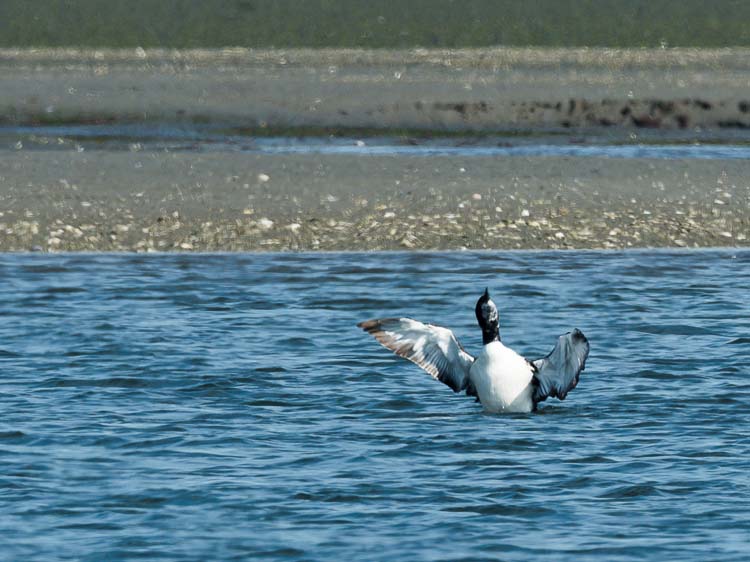On Saturday the 16th, Dorothy and I took a short sojourn to south Surrey. Our destination was Blackie Spit, where a number of interesting birds had been reported in the last week.
When we first arrived, we walked out to the end of the spit and spied a Common Loon floating offshore. |
|
 |
| After a few minutes, he looked up and tried to catch something dropped by another bird. It seems he got a little off-balance. |
|
 |
To be fair, though, he did have the sun in his eyes. It's hard to make a catch in that situation.
The other birds that caught our attention at the end of the spit were Caspian Terns. Some were on the far shore and some were cruising on high, looking for tasty fish. |
|
 |
| While looking across towards the terns, we got distracted by a shiny seal head. Actually, there were several of them all around in the same area. This one was quite a distance away, but in the picture I also got a grebe that I hadn't realized was there. |
|
 |
Well, it's either a grebe or a very small Loch Ness Monster.
Here is the assemblage of Caspian Terns that were on the far shore. The big grey lumps in the grass are Great Blue Herons. Must've been about fifteen of them scattered across the field back there. |
|
 |
We don't get Caspian Terns very much over the course of a year, so I was happy to see them.
We walked from the spit itself over to the Savenye protected area, where the first couple of things I found photogenic were on the ground. First up is a deep brown grasshopper. |
|
 |
| Next was a beetle that kept running around, distracting me from the grasshopper. So I decided to shoot the beetle, and I'm glad I did. I looked this fellow up in an insect reference, and he's some sort of Tiger Beetle. |
|
 |
Given where he was found, he could very well be a Beach Dune Tiger Beetle (Cicindela Hirticollis), which my reference says is increasingly rare. It wasn't rare at Blackie Spit; we saw several of them.
My next subject was a hungry juvenile Ring-Billed Gull. RIng-Billed is a common gull at Blackie. This guy had found an apple. |
|
 |
| By picking it up and giving his head a shake, he was able to break off pieces and eventually consume the whole thing. |
|
 |
| And Jiminy! was he hungry! He followed up his fruity meal with a buggy little protein snack. |
|
 |
| Once in the protected area, we saw little other than a gathering of shorebirds—mostly Black-Bellied Plovers—on the shore. |
|
 |
| In case you're wondering why those birdswith white breasts above are called "black-bellied", check out this fellow who has not yet molted out of his breeding (summer) colors. |
|
 |
| There were a few other kinds of birds out near the plovers. This is a Northern Pintail, looking to me like a male in the nonbreeding plumage. |
|
 |
| There were also some dowitchers; I'd guess Short-billed Dowitcher because the body doesn't seem bulky enough for a long-billed, but it's been a long time since I studied dowitchers and it really is just a guess. Here's a dowitcher with two of the plovers. |
|
 |
We weren't finding much, and it was a fairly warm day, so we took a break and had some affogato (expresso on ice cream) in Crescent Beach. Yum! Suitably recharged, we stopped at Elgin Park on our way out.
We were watching some finchy birds when Dorothy spotted a Brown Creeper going up an oak trunk. He proved difficult to get a good shot of; he wasn't staying still for long, and much of the trunk was in the shade. |
|
 |
He went up the trunk at least four times while we were there. When he got to a point reasonably far up, he'd fly back down to the bottom and start again.
There were plenty of Yellow-Rumped Warblers around, like this one I caught in the middle of explaining: "it's not yellow on the rump below the tailfeathers, it's yellow on the rump above the tailfeathers." |
|
 |
| Black-capped Chickadees were out in force. Here one stopped and struck a dignified pose for me. |
|
 |
It's hard to tell where his eyes are.
A few Cedar Waxwings came by, as well, with their sunglasses on and the bright yellow tip to their tails. |
|
 |
| Our last real treat of the day was another seal, this one much closer to us than the ones at Blackie had been. |
|
 |
| With not much nature to shoot, I took a photo of a big orange barn and cornfield across the way. I couldn't fit the whole barn into the shot, as I'm now using a prime lens. A prime lens is a lens that doesn't zoom. So the only way I could get more of the barn in the shot would be to change lenses, and I was tiring, so I contented myself with trying to compose the shot using the prime. |
|
 |
And that was that for our day in the field.
Giving his own head a shake,
Tom
|
|